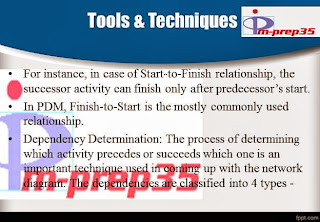Estimate Cost
Once the scope is baselined in terms of deciding the project boundaries and also, as soon as the schedule is baselined in terms of coming up with the schedule with details about the activities, their duration and the resource requirements, one of the next steps is to come up with the cost estimate.
Prior to coming up with the cost estimate, it is necessary to have a plan as as to how the estimation process will be covered.
Based on the above understanding, here are the inputs to the estimate cost process:
1. Scope baseline: What is the boundary to be covered.
2. Schedule baseline: The schedule having details about the activities, their duration and the resource count for each activity.
3. Human Resource Management Plan: While the resource count gets covered in the project schedule, the resource characteristics,personnel rates gets covered in human resource management plan.
4. Cost Management Plan: How to estimate the cost for this project, what tools to use?
Generally, PM plan can be taken as an input (to cover all of the above) since it has the different baselines and plans too but , to be specific and vital, specific inputs like, scope and schedule baselines are listed as inputs.
Going ahead, the following are other inputs,
5. Enterprise Environmental Factors - Cost estimation can have external factors like, government approval, license cost etc. to be considered
6. Organizational Process Assets - For leveraging any prior experience or template reuse because this is a vital process and it is necessary to follow a process and reuse prior experience as much.
7. Risk Register - what risks need to be accounted (contingencies cost)
Cost estimation is understandably a vital process and so, it needs experience in terms of anticipating all issues and covering those in the estimate. Looking at the scope and schedule baselines, the cost is estimated for the project activities. Not all the times there is enough information to do the estimate. So, different types of estimation techniques need to be followed based on experience. Personnel rates are applied alongwith activity duration and resource count to come up with the cost estimate, first at activity level , summing it up to the project level using a project management software. Estimation for any risks is also an important aspect since it helps add a buffer to the actvities and the project as such. Different types of estimation techniques like top-down approach, bottom-up estimation are used. Cost of conformance and non-conformance in terms of quality is also an important aspect to be covered. All these are added on to a project management software like Microsoft Project Plan (MPP).
Based on the above understanding, here are the tools and techniques:
Project Management Software - for activity-wise cost estimation and cumulation
Different estimation techniques: based on available information, different techniques might be used:
1. Bottom-Up estimation - results in more accurate estimates since the estimator knows what time it takes to complete each activity since he/she has done something like this before
2. Top-Down or Analogous estimation - based on experience or comparison with other projects a high-level estimation is arrived at. Here accuracy may not be there but if this is coupled with experience then a good estimate can be arrived at. Mostly this estimate has a range.
3. Parametric estimation - if the model is good, can result in accurate estimates. e.g., rate / sq ft multiplied with no. of sq ft to come up with the cost for the land as a whole.
4. Three-point estimating: Optimistic, most likely and pessimistic estimates used to come up with the actual estimate for the activity.
Based on the understanding of the process, the following are generally important techniques for this process -
Expert Judgment
Analytical Techniques like brainstorming, delphi technique are used
Apart from the above, the other techniques used are -
Cost of Quality: Cost of conformance and cost of non-conformance
Reserve Analysis: What amount of reserve is needed to account for known and unknown risks. They are usually a percentage of the estimate.
Vendor bid analysis: Based on what is the bid rate, the actual project cost can be benchmarked and then estimated.
Outputs:
Proj Document Updates: There might be a need to add missing information (onto other project documents) uncovered as a result of this process.
Activity Cost Estimates: For each activity what is the cost, based on no. of resources used and the duration for which they are used alongwith the personnel or resource rate for the concerned resources.
Basis of Estimates: On what basis this estimate was arrived at. Any supporting documents, attributes to support the estimation process and make it reliable.
Visit
http://pm-prep35.com/ittolaunchpage.aspx











































